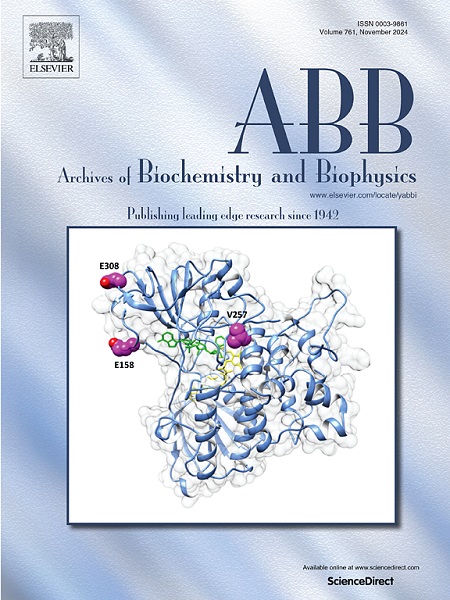香豆素-三唑复合物的合成、抗增殖、诱导乳腺癌细胞凋亡和芳香酶抑制:体外和计算机研究。
IF 3.8
3区 生物学
Q2 BIOCHEMISTRY & MOLECULAR BIOLOGY
引用次数: 0
摘要
乳腺癌是全世界女性中最常见的癌症之一。除了临床药物的可用性外,耐药性和相当大的副作用也是人们关注的问题,促使人们需要发现新的抗癌药物。芳香酶抑制是激素依赖性乳腺癌治疗的有效策略之一。三唑、香豆素和isatin是目前在药物设计领域备受关注的杂环支架。分子杂交是一种众所周知的获得具有改进效力和性能的新分子的策略。本文合成了27个以三唑为基础的杂合体(香豆素-三唑系列5-6和isatin-三唑系列7),并研究了它们的抗增殖、诱导凋亡和芳香酶抑制潜能。对激素依赖性乳腺癌(T47D)细胞株的抗增殖研究表明,香豆素-三唑5h (R = NO2)和6i (R = SO2NH2)是两种最有效的抗增殖药物。特别是,化合物5h的效价与参比药阿霉素相当,选择性指数更高。此外,香豆素-三唑5h可诱导雌激素依赖性乳腺癌(MCF-7)细胞凋亡。此外,芳香酶抑制实验结果表明,4种化合物可能是芳香酶抑制剂(即5i, 6f, 6g和6i, IC50 = 1.4-2.4 μM)。构建了两个具有较好预测性能的QSAR模型,揭示了影响抗增殖和芳香酶抑制作用的关键特性。进行分子对接以阐明与目标芳香酶的可能结合方式。强调了粘合的关键结构特征。此外,还评估了排名靠前的化合物的类药物性质,以确保其成功开发的可能性。本文章由计算机程序翻译,如有差异,请以英文原文为准。

Synthesis, anti-proliferation, apoptosis induction in breast cancer cells, and aromatase inhibition of coumarin-triazole hybrids: In vitro and in silico studies
Breast cancer is one of the most common cancers found in women worldwide. Besides the availability of clinical drugs, drug resistance and considerable side effects are concerning issues driven the needs for the discovery of novel anticancer agents. Aromatase inhibition is one of the effective strategies for management of hormone-dependent breast cancer. Triazole, coumarin, and isatin are heterocyclic scaffolds holding great attention in the field of drug design. Molecular hybridization is a well-known strategy to achieve new molecules with improved potency and properties. Herein, a set of 27 triazole-based hybrids (i.e., coumarin-triazoles series 5–6 and isatin-triazoles series 7) were synthesized and investigated for their anti-proliferation, apoptosis induction, and aromatase inhibitory potentials. Anti-proliferative study against the hormone-dependent breast cancer (T47D) cell line indicated that coumarin-triazoles 5h (R=NO2) and 6i (R=SO2NH2) were the two most potent antiproliferative agents. Particularly, compound 5h showed comparable potency and superior selectivity index than that of the reference drug, doxorubicin. Moreover, the coumarin-triazole 5h induced cellular apoptosis of the estrogen-dependent breast cancer (MCF-7) cells. Additionally, findings from the aromatase inhibitory assay suggested four compounds as potential aromatase inhibitors (i.e., 5i, 6f, 6g and 6i, IC50 = 1.4–2.4 μM). Two QSAR models with preferable predictive performances were constructed to reveal key properties influencing antiproliferative and aromatase inhibitory effects. Molecular docking was conducted to elucidate the possible binding modalities against the target aromatase enzyme. Key structural features essential for the binding were highlighted. Moreover, the drug-like properties of top-ranking compounds were assessed to ensure their possibilities for successful development.
求助全文
通过发布文献求助,成功后即可免费获取论文全文。
去求助
来源期刊

Archives of biochemistry and biophysics
生物-生化与分子生物学
CiteScore
7.40
自引率
0.00%
发文量
245
审稿时长
26 days
期刊介绍:
Archives of Biochemistry and Biophysics publishes quality original articles and reviews in the developing areas of biochemistry and biophysics.
Research Areas Include:
• Enzyme and protein structure, function, regulation. Folding, turnover, and post-translational processing
• Biological oxidations, free radical reactions, redox signaling, oxygenases, P450 reactions
• Signal transduction, receptors, membrane transport, intracellular signals. Cellular and integrated metabolism.
 求助内容:
求助内容: 应助结果提醒方式:
应助结果提醒方式:


